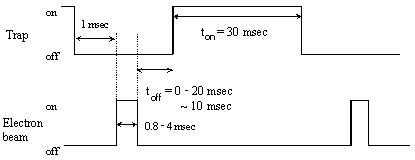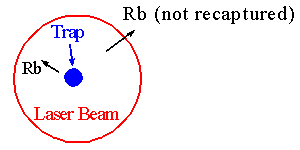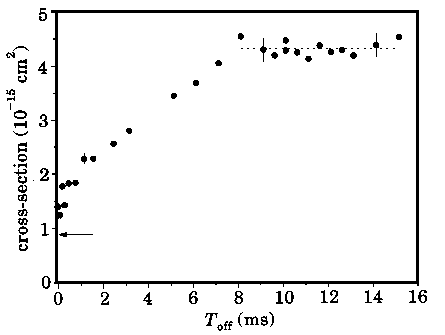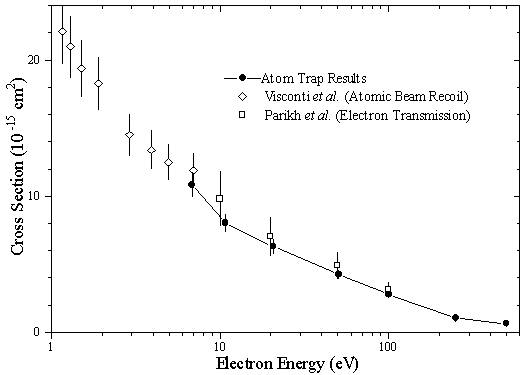IV) Laser-Cooled Trapped Atoms for electron scattering Cross Sections
B. Measurement of Total Scattering cross sections
Method to determine the total cross section
To determine the total scattering cross section, we trap a number of atoms. Next we turn off the trap lasers (and the magnetic field since it would distort the electron beam). Then we pulse the electron beam on. Atoms in the trap that undergo a collision are kicked out of the center of the trap. We wait some period of time for the atoms to move out beyond the range of 1cm diameter laser beam size. Finally, we turn the trap back on to corral all the trapped atoms that wandered off due to their thermal motion, and determine the fraction of atoms lost due to electron-atom scattering.
The experiment, however, is not done quite as described. The atom trap sits in chamber full of room temperature Rb vapor. When the trap lasers are on, the slowest atoms in the Boltzman distribution are continually added to the trap. This gain mechanism is offset by trap losses due to collisions with fast moving background atoms. Hence, when turn the trap off and pulse the electron beam on, we have losses due to both electron-atom, and atom-atom collisions. Likewise, when we turn the trap on, we will not only collect the atoms that were not scattered, but also new atoms from the background Rb vapor. This requires us to not measure the fraction of atoms lost from the trap, but the fractional loss rate.
 |
measure: Loss rate without electron beam Loss rate with electron beam |
Results: Qtotal(E)
Recall that we need to turn the trap lasers off long enough for atoms that have suffered a collision to travel outside the range of the laser beams. By waiting for only a finite period of time, we will retrap som atoms that we shouldn't -very slow moving atoms that have large scattering angles. By waiting longer and longer of periods of time before we turn the trap back on, we can collect more and more of these slow moving atoms. If we wait long enough, the loss rate should converge. A plot (for 50eV electron energy) of loss rate vs. delay time demonstrates this:
Note that for long delay times, the answer does infact converge. Also note that the limit of the delay time going to zero also has some meaning. If we turn the trap lasers on immediatly after the electron gun pulse, we should retrap virtually all of the atoms. The only losses will be very fast atoms (small angle scattering) and ionizing collisions (ions are not retrapped since the trap lasers are tuned to a atomic transition). The arrow in the curve above is the loss rate calculated from the known ionization cross section, and should represent a lower limit on our measured loss rate.
To convert our measured loss rate into a cross section we need to measure the electron beam current and the electron current density at the center of the beam (since the trapped atom ball is much smaller than the electron beam). Due to the simplicity of the experiment's design, we can obtain a relativly low 9% overall uncertainity. A comparison to results obtained with much more complicated experiments is shown below.

references:
Electron Collision Cross-Sections Measured with the Use of a Magneto-Optical Trap. R. S. Schappe, P. Feng, L. W. Anderson, C. C. Lin, and T. Walker, Europhys. Lett. 29 (1995) 439-444.
 |
 |
 |